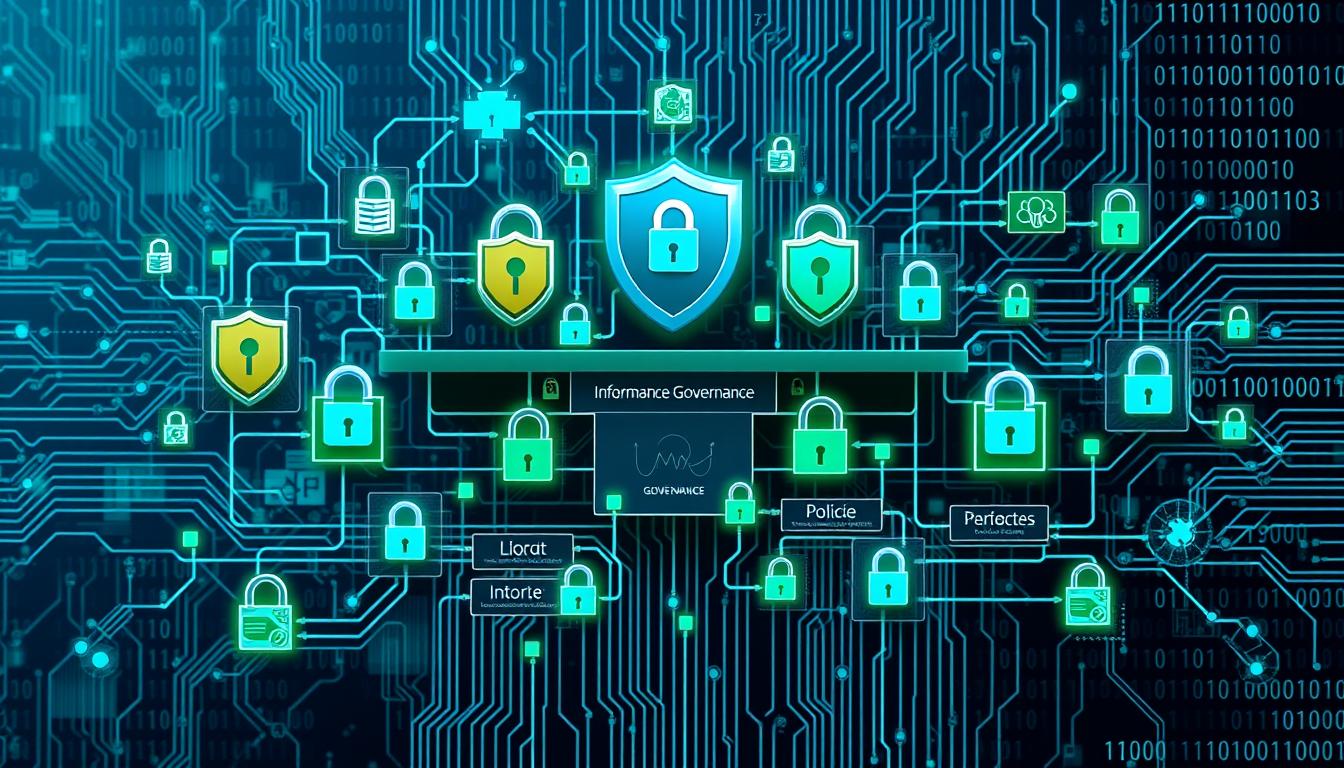
Did you know that 42% of healthcare organizations don’t have an incident response plan? This shows how important information security governance frameworks are today. With cyber threats growing and rules getting stricter, it’s more vital than ever to have good cybersecurity governance models.
This guide will explore information security governance frameworks (ISGF). We’ll look at their key parts, why they matter, and how to set up a plan to protect sensitive info. It’s key to understand and use strong governance frameworks to manage risks and keep your data safe.
Understanding Information Security Governance
Information security governance is key to managing cybersecurity in organizations. It sets up policies and strategies to protect data from cyber threats. With threats changing fast, it’s vital to keep up and stay accountable.
Definition and Importance
Information security governance manages cybersecurity roles and responsibilities. It’s about using resources to boost security and protect sensitive data. About 35% of companies have a governance framework, showing its growing importance.
But, 50% of IT leaders say their companies lack a clear strategy. This gap can lead to security weaknesses.
Key Objectives of Governance
Effective information security governance has several key goals:
- Resource allocation to ensure proper funding and staffing
- Compliance with industry regulations and standards—75% of organizations prioritize this aspect
- Risk management strategies to identify and mitigate threats
- Implementation of advanced security measures, with 65% utilizing encryption
Good governance makes organizations more resilient and secure. Companies with strong frameworks manage incidents better. They also see a 20% rise in using Incident Response Plans (IRP).
Also, 82% of companies say good governance helps with business continuity and disaster recovery.
| Governance Objectives | Impact |
|---|---|
| Resource Allocation | Ensures proper investment in security technologies and personnel |
| Compliance | Helps organizations avoid penalties and fosters trust |
| Risk Management | Enhances ability to predict and respond to threats |
| Advanced Security Measures | Reduces likelihood and impact of security breaches |
90% of cybersecurity leaders say strong governance policies are essential. This shows that a unified approach manages risks and aligns with business goals. Also, 76% of organizations say their executives are actively involved in cybersecurity governance.
What are Information Security Governance Frameworks?
Information security governance frameworks are structured ways for organizations to handle and reduce security risks. They include key elements for protecting sensitive data and following industry rules. Knowing what makes up a security framework shows how it impacts an organization’s safety and integrity.
Components of a Security Framework
Several important parts make up a good information security governance framework:
- Risk Management: Finding, checking, and fixing possible risks to keep data safe.
- Security Policies: Setting clear rules that guide how to keep data secure.
- Procedures and Controls: Using steps and rules to follow policies and keep security strong.
- Employee Training: Teaching employees about security to avoid mistakes.
- Monitoring: Checking and updating security plans to stop threats.
- Incident Response Strategies: Planning for and fixing security problems quickly.
Types of Security Frameworks
There are many types of information security governance frameworks. Each one is designed for different needs and rules:
| Framework | Description | Best Suited For |
|---|---|---|
| NIST Cybersecurity Framework | A risk-based approach that provides guidelines for managing and reducing cybersecurity risk. | Organizations of all sizes seeking a flexible model. |
| ISO/IEC 27001 | International standard for information security management systems (ISMS). | Establishing and managing an effective information security management system. |
| COBIT Framework | A framework for developing, implementing, monitoring, and improving IT governance and management practices. | Organizations focusing on IT governance. |
| CIS Controls | A set of recommended actions for cyber defense that provide specific and actionable ways to thwart the most common attacks. | Organizations needing immediate remediation strategies. |
Reasons for Implementing Governance Frameworks
Organizations face big challenges in protecting sensitive information. Using information security governance frameworks is key to protecting data well. These frameworks help by using physical, technical, and administrative controls. They also help follow rules and regulations.
Ensuring Complete Protection
Creating a governance framework helps companies lower risks from data breaches. It makes their security better. About 60% of data breaches happen because of bad access controls and poor information governance.
By using a strong framework, companies can make their data security better. This is shown by 57% of companies saying they respond faster to incidents. Also, having certified professionals like those from ARMA can make following rules up to 70% better.
Helping Follow Rules and Regulations
Following rules is very important for organizations today. About 85% of companies say using a governance framework makes them follow rules better. This includes rules like PCI DSS, HIPAA, and FedRAMP.
This helps businesses know what they must do and do it. It also lowers the chance of legal trouble. Companies that use good information governance can save up to 25% on following rules. Also, 75% of organizations say it makes data handling clearer.
| Statistic | Impact |
|---|---|
| 85% of organizations | Improved compliance with regulatory requirements |
| 60% of data breaches | Linked to improper access controls |
| 40% reduction | In time spent on compliance-related tasks |
| 57% of companies | Improved incident response times |
| 50% increase | In decision-making efficiency with a governance strategy |
| 35% decrease | In data mismanagement incidents with automated tools |
| 66% of business leaders | Positive impact on risk management practices |
Key Stakeholders in Information Security Governance
Effective information security governance needs many key players. Executive management is key in setting the security strategy and getting the resources needed. Knowing who these stakeholders are helps make an organization’s security better.
Role of Executive Management
Executive management is a key part of the governance team. They decide how much to spend on protecting information and make sure security is a priority. Their leadership is vital in solving big security problems that could harm the business or steal important information.
With most businesses relying on technology, the executive team’s commitment to security is key. It helps keep operations smooth and builds trust with customers.
- Developing security policies and strategies
- Understanding and mitigating risks associated with technology
- Ensuring sufficient investment in security technologies
- Facilitating organizational compliance with regulations such as GDPR and HIPAA
Importance of IT and Security Teams
The success of information security governance depends on IT and security teams working together. They are key in setting up security measures, watching systems, and handling security issues quickly. They also teach employees about security, creating a culture that values security.
Good communication between management and these teams is important. It helps the organization deal with security problems and breaches.
| Stakeholder Role | Responsibilities | Key Objectives |
|---|---|---|
| Executive Management | Establish security strategy, allocate resources | Reduce operational costs, enhance stakeholder confidence |
| IT Team | Implement security controls, monitor systems | Ensure system integrity, reduce service disruptions |
| Security Team | Respond to incidents, educate employees | Maintain security awareness, protect organizational reputation |
Popular Information Security Governance Frameworks
It’s key for companies to know about top information security governance frameworks. The NIST Cybersecurity Framework (NIST CSF) and ISO/IEC 27001 are well-known. They give clear steps and rules to help firms build strong security practices.
NIST Cybersecurity Framework (NIST CSF)
The NIST CSF was created in 2014 and got a big update in February 2024. It’s a detailed guide for better security management. It has five main parts: Identify, Protect, Detect, Respond, and Recover. It helps firms manage risks and plan for incidents.
ISO/IEC 27001
ISO/IEC 27001 sets rules for an information security management system (ISMS). It focuses on a methodical way to check risks and protect important data. It’s often used with ISO/IEC 27002, which lists specific security controls.
COBIT Framework
COBIT helps manage and govern IT in companies. It offers best practices to match with business goals. It’s important for keeping IT in line with rules.
CIS Controls
The CIS Controls Framework has 20 key controls, split into levels. It focuses on basic cybersecurity steps. It guides firms on how to fight cyber threats.
Information Security Governance Frameworks Implementation
The success of information security governance framework implementation depends on understanding an organization’s needs. This starts with identifying security goals and checking the current security level. It’s important to know the weaknesses and gaps to make the framework fit the specific challenges.
Assessment of Organizational Needs
Assessing organizational needs is key. This includes:
- Setting security goals that match business objectives.
- Checking if current security measures work well.
- Figuring out the resources needed for setup and upkeep.
This groundwork helps build a solid security governance system. It improves how well an organization manages risks.
Establishing Policies and Procedures
Creating clear policies and procedures is critical. These documents outline how to follow governance strategies and who does what. A good governance structure makes sure everyone is accountable and security fits into daily work.

Having a detailed framework is key to keeping data safe. Regular updates to policies help fight new threats. Companies with clear policies are less likely to face security problems.
Best Practices for Information Security Governance
Effective information security governance needs a lot of effort. It’s about setting up and keeping strong security practices in your organization. You must focus on a culture of security awareness and keep improving your security measures.
Building a Culture of Security Awareness
It’s important to make all employees aware of security. Regular training helps them know about security policies and new threats. This makes your team ready to spot and deal with risks.
Management’s support is key. It helps make sure everyone is on board and resources are used well for security.
Continuous Monitoring and Improvement
It’s important to keep an eye on your security all the time. Regular risk assessments help find and tackle cybersecurity risks. You should also track how well your security is doing with clear goals.
Improving security keeps you safe from cyber threats. It also helps you follow the law and meet regulations.
Challenges in Implementing Governance Frameworks
Setting up information security governance frameworks is tough. It faces many challenges that can weaken an organization’s security. These issues often come from not having enough support from management and limited resources. Knowing these problems is key for improving governance strategies.
Lack of Management Buy-In
One big problem is when management doesn’t support these frameworks. Many top leaders don’t see how important good cybersecurity is. This lack of support makes it hard to start important security projects.
About 60% of companies struggle because they don’t get enough help from their bosses. Also, almost 70% of employees are slow to accept new governance rules. This makes it even harder to get things done.
Resource Constraints
Not having enough resources is another big issue. Companies often don’t have enough time, money, or skilled people to build strong security. It’s shown that 75% of companies say they can’t afford to make good governance plans because of this.
Small businesses are hit hard because they can’t afford the tools and training they need. Also, complex IT systems make it hard to keep up with new threats. This makes it tough for companies to stay safe.

Compliance with Information Security Governance Frameworks
It’s key for any company to know about compliance with information security governance frameworks. Following these rules keeps data safe and avoids big fines. Laws like GDPR and HIPAA set the rules for how companies should handle data. Not following these rules can hurt a company’s finances and reputation.
Regulatory Standards and Their Implications
Regulations set rules for different industries. For example, GDPR can fine companies up to €20 million for data breaches. The CCPA also has strict rules, with fines for not following them.
On the federal level, HIPAA fines can be from $100 to $1.5 million. Companies must also follow FedRAMP’s rules, like 26 NIST 800-53 control families. Staying compliant is not just a choice; it’s a must to protect data and keep trust.
Ensuring Continuous Compliance
Companies must keep up with continuous compliance. This means regular training on new rules. GDPR requires yearly privacy training, showing the importance of ongoing learning.
The Federal Civilian Executive Branch (FCEB) agencies must follow certain rules. For example, BOD 20-01 requires a vulnerability disclosure policy. Not following these rules can lead to legal trouble and security issues.
Strategic Information Security Governance
In today’s digital world, linking strategic information security governance with business goals is key to success. This alignment not only guards sensitive data but also keeps operations running smoothly and in line with laws.
Aligning Business Goals with Security Goals
Aligning business and security goals needs a clear governance policy. Companies with a solid information security governance framework see better alignment. Yet, 70% of firms struggle to link their security plans with business goals.
This gap can cause compliance issues and poor security management. When security governance is part of business strategies, it helps everyone speak the same language. This leads to better communication and teamwork, essential for success.
By using structured governance, companies can cut down on compliance problems by 85%. This shows the importance of setting clear goals.
The Role of Risk Management
Risk management is central to strategic information security governance. Knowing possible threats and focusing on high risks helps in making smart security choices. Without key staff, like compliance officers, setting up good governance is hard.
Using tools for detailed risk assessments can help see how well a company follows rules and how breaches might affect it. Investing in advanced monitoring tools helps spot threats early, protecting sensitive data.
To see how strategic information security governance boosts performance, look at this table:
| Aspect | Without Strategic Governance | With Strategic Governance |
|---|---|---|
| Alignment of Goals | Poor alignment, leading to mismanaged priorities | Clear connection between business and security objectives |
| Risk Management | Limited effectiveness in identifying and mitigating risks | Proactive identification and prioritization of risks |
| Compliance Adherence | Higher likelihood of compliance breaches | Reduced risk of penalties and legal issues |
| Personnel Challenges | Inconsistent application of security policies | Dedicated team to ensure effective governance |
Conclusion
In today’s digital world, information security governance frameworks are key. This guide showed how they protect sensitive data and follow changing rules. Companies using these frameworks are 40% less likely to face data breaches.
By focusing on governance, you protect your assets. This could save you from big financial losses. IBM says the average breach costs $3.86 million.
Good governance means being proactive against cyber threats. It also builds a culture of security awareness. With cyber threats on the rise, strong security measures are more important than ever.
Using frameworks like the NIST Cybersecurity Framework helps manage risks better. It also makes finding and fixing breaches faster. This cuts down the time from 205 days to 73 days.
Effective information security governance is a team effort. 87% of executives say they play a big part in creating a secure culture. Better communication and clear roles lead to better compliance and a strong security stance.
Source Links
- Mastering Security Frameworks: A Comprehensive Guide
- Understanding Security Frameworks: 14 Common Frameworks Explained
- Guide to Security Frameworks: Which one do you need?
- What Is Information Security Governance in Cybersecurity?
- Understanding information security governance
- What Is Information Security Governance?
- What is a Data Security Governance Framework?
- Information Governance: Why Is It Important?
- Understanding IT security frameworks: Types and examples
- Information Security Governance
- A Guide to CISM Domain 1: Information Security Governance
- Top 11 cybersecurity frameworks in 2024
- Top 9 Cybersecurity Frameworks in 2024
- Top IT Security Frameworks and Standards Explained
- Top 12 IT security frameworks and standards explained | TechTarget
- Information Security Governance Framework Guide for IT Activities
- Overview: What is a Security Governance Framework | Gutsy
- Information Security Governance – ERMProtect Cybersecurity
- Implementing Robust IT Security Governance: Best Practices from various Global Software Companies
- Implementing Security Frameworks: Challenges and Best Practices –
- Overcoming Obstacles: Challenges and Solutions in IT Governance Implementation
- Governance of Information Security
- 15 Regulatory and Security Compliance Frameworks to Secure Your Business | Secureframe
- Cybersecurity Governance | CISA
- A Guide to Information Security Governance
- Information Security Governance: Framework for IT Compliance
- 7 Cybersecurity Frameworks to Reduce Cyber Risk in 2024
- Information Security Governance Roles and Responsibilities
- Top 10 IT Security Frameworks and Standards Explained!



